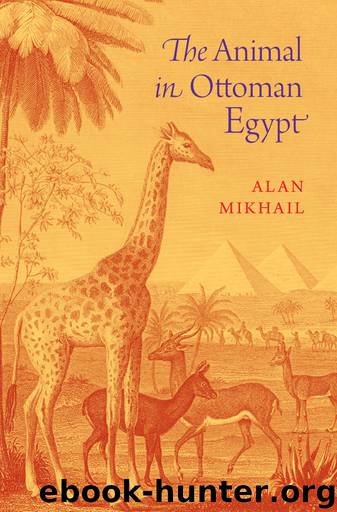The Animal in Ottoman Egypt by Alan Mikhail

Author:Alan Mikhail
Language: eng
Format: epub
Publisher: Oxford University Press
Published: 2017-03-13T16:00:00+00:00
1. Early Modern Human and Animal
1.DWQ, Maḥkamat al-Baḥayra 21, p. 177, case 343 (24 N 1206/16 May 1792). For a description of the village of Surunbāy, see Muḥammad Ramzī, al-Qāmūs al-Jughrāfī lil-Bilād al-Miṣriyya min ʿAhd Qudamāʾ al-Miṣriyyīn ilā Sanat 1945, 6 vols. in 2 pts. (Cairo: al-Hayʾa al-Miṣriyya al-ʿĀmma lil-Kitāb, 1994), pt. 2, vol. 2: 270. On the courts and wider legal system of Ottoman Egypt, see El-Nahal, Judicial Administration of Ottoman Egypt. For the biographies of various judges from the period, see Aḥmad ibn Aḥmad al-Damīrī, Quḍāt Miṣr fī al-Qarn al-ʿĀshir wa al-Rubʿ al-Awwal min al-Qarn al-Ḥādī ʿAshar al-Hijrī, ed. ʿAbd al-Rāziq ʿAbd al-Rāziq ʿĪsā and Yūsuf Muṣṭafā al-Maḥmūdī (Cairo: al-ʿArabī lil-Nashr wa al-Tawzīʿ, 2000); Ibn Abī al-Surūr, al-Tuḥfa al-Bahiyya, 163–74.
2.Another possible explanation for al-Ḥājj Muṣṭafā’s seemingly futile action in bringing this case to court was that it represented some sort of mid-feud snapshot of a tumultuous relationship that had been going on for quite some time. In other words, perhaps al-Ḥājj Muṣṭafā brought this case to court in an attempt to get revenge on al-Shābb ʿAlī; or perhaps al-Ḥājj Muṣṭafā sought to raise in the minds of others in their community the possibility that al-Shābb ʿAlī was a trickster who acted dishonestly; or perhaps al-Ḥājj Muṣṭafā even meant to suggest that al-Shābb ʿAlī came in the middle of the night and killed the ox himself. There are several plausible scenarios. Whatever the case may have been, the important point to take away is that the decision to go to court was one that had many possible motivations with various consequences. It is not outside the realm of possibility—indeed, it is quite likely—that plaintiffs brought cases to court knowing full well they would lose them. The goal of bringing a case to court, in other words, was not always (or only) to win it. On these and other strategic uses of Ottoman courts, see Boğaç A. Ergene, Local Court, Provincial Society and Justice in the Ottoman Empire: Legal Practice and Dispute Resolution in Çankırı and Kastamonu (1652–1744) (Leiden: Brill, 2003); Leslie Peirce, Morality Tales: Law and Gender in the Ottoman Court of Aintab (Berkeley: University of California Press, 2003).
3.In 1731, for example, 500 mules were used to move supplies and troops to the Ottoman border with Iran. These animals were one of the few ways to transport an enormous load over vast distances and rugged terrain. BOA, Cevdet Askeriye 16011 (3 M 1144/8 July 1731).
4.Some writers even went so far as to say that the impressive size and power of Egypt’s mules, donkeys, and horses were unmatched anywhere in the world. See the two slightly different versions of the following text: Muḥammad ibn Muḥammad ibn Ẓahīra, al-Faḍāʾil al-Bāhira fī Maḥāsin Miṣr wa al-Qāhira, Beinecke, Landberg MSS 105, 80v–83r; idem., al-Faḍāʾil al-Bāhira fī Maḥāsin Miṣr wa al-Qāhira, Beinecke, Arabic MSS suppl. 395, 71v–73v. For an eleventh-century description of the physical attributes of horses, see ʿUbayd Allah ibn Jibrīl ibn Bakhtīshūʿ, ʿIqd al-Jumān fī Ṭabāʾiʿ al-Ḥayawān wa al-Insān, Maʿhad al-Makhṭūṭāt al-ʿArabiyya, Cairo, al-Kīmiyāʾ wa al-Ṭabīʿiyāt 66, 15v–17r.
Download
This site does not store any files on its server. We only index and link to content provided by other sites. Please contact the content providers to delete copyright contents if any and email us, we'll remove relevant links or contents immediately.
Cecilia; Or, Memoirs of an Heiress — Volume 1 by Fanny Burney(31333)
Cecilia; Or, Memoirs of an Heiress — Volume 3 by Fanny Burney(30934)
Cecilia; Or, Memoirs of an Heiress — Volume 2 by Fanny Burney(30889)
The Great Music City by Andrea Baker(21317)
We're Going to Need More Wine by Gabrielle Union(18074)
Bombshells: Glamour Girls of a Lifetime by Sullivan Steve(13109)
Pimp by Iceberg Slim(12932)
All the Missing Girls by Megan Miranda(12752)
Fifty Shades Freed by E L James(12451)
Norse Mythology by Gaiman Neil(11883)
Talking to Strangers by Malcolm Gladwell(11879)
Crazy Rich Asians by Kevin Kwan(8349)
Mindhunter: Inside the FBI's Elite Serial Crime Unit by John E. Douglas & Mark Olshaker(7834)
The Lost Art of Listening by Michael P. Nichols(6474)
Enlightenment Now: The Case for Reason, Science, Humanism, and Progress by Steven Pinker(6406)
Bad Blood by John Carreyrou(5769)
The Four Agreements by Don Miguel Ruiz(5511)
Weapons of Math Destruction by Cathy O'Neil(5037)
We Need to Talk by Celeste Headlee(4870)
